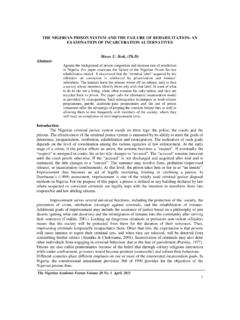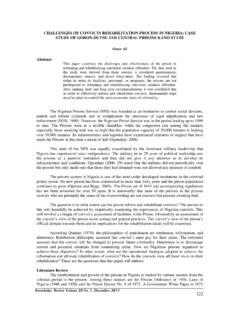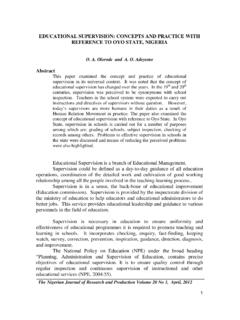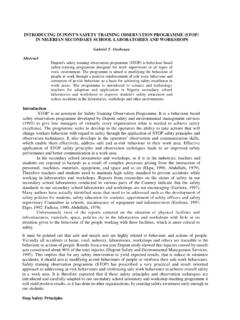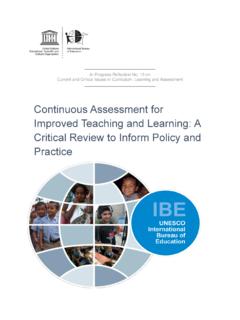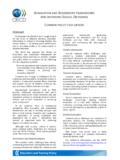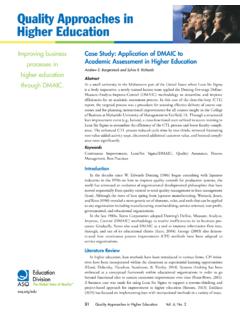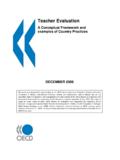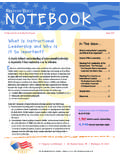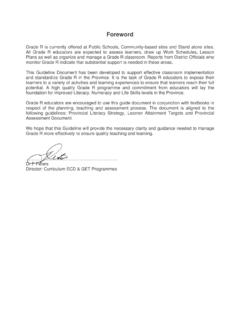Transcription of CONTINUOUS ASSESSMENT IN PRIMARY AND …
1 489. CONTINUOUS ASSESSMENT IN PRIMARY AND SECONDARY. SCHOOLS: ISSUES AND PROBLEMS. R. A. Ahukanna, Department of Educational Foundations and Administration/Psychology, Alvan Ikoku Federal College of Education, Owerri. M. I. Onu, Department of Educational Foundations and Administration/Psychology, Alvan Ikoku Federal College of Education, Owerri. P. N. Ukah, Department of Educational Foundations and Administration/Psychology, Alvan Ikoku Federal College of Education, Owerri. Abstract The paper discusses the issues and problems of CONTINUOUS ASSESSMENT in PRIMARY and secondary schools.
2 It explains the meaning of CONTINUOUS ASSESSMENT as the mechanism whereby the final grading of learner's cognitive, affective and psychomotor domains of learning systematically takes account of their performance during a given period of schooling. It also cited the legal provision of CONTINUOUS ASSESSMENT in our educational system. The purposes of CONTINUOUS ASSESSMENT were highlighted to include finding out the extent of students' knowledge, understanding and skills learnt. The students' weakness and strengths which serve as a feedback to the teacher on where extra work needs to be done.
3 The problems and weakness of CONTINUOUS ASSESSMENT were highlighted to include that some teachers do not posses the required competences for the implementation of CONTINUOUS ASSESSMENT . It was also observed that the task is weighing the teachers down. Teachers focus their greatest attention on measuring cognitive attainment rather than affective and psychomotor behaviours of the students. It was observed that majority of the teachers in our public PRIMARY and secondary schools exhibit a high level of incompetence in the use of statistical tools. The skill is necessary in presenting students' performance in a neat and logical manner.
4 The benefits of CONTINUOUS ASSESSMENT is that, it is guidance oriented since it involves data gathering over a long period of time, yields more accurate data for the teacher to modify instruction. It is recommended that government should mount more intensive seminars and workshops to educate teachers on the appropriate principles of CONTINUOUS ASSESSMENT . That teachers need to be professionally and attitudinally prepared to operate the system. 490. Journal of Teacher Perspective be by CONTINUOUS ASSESSMENT . The NPE. Educational ASSESSMENT provides (2004) also stated that educational the necessary feedback education ASSESSMENT and evaluation shall be practitioners require to maximize the liberalized by their being based in whole or outcome of educational efforts.
5 It is part of in part on CONTINUOUS ASSESSMENT of the students learning. Teachers have always progress of the individual. What then is made judgments about the progress of their CONTINUOUS ASSESSMENT ? Falayo (1986). students from the ASSESSMENT . The defined CONTINUOUS ASSESSMENT as the ASSESSMENT of learners performance mechanism whereby the final grading of provides the objective evidence necessary learners in cognitive, affective and in the decision making process. psychomotor domains of learning Cone (1991:653) stated that good systematically takes account of their measurement resulting in accurate data is performance during a given period of the foundation of sound decision making.
6 Schooling Prior to the institution of The major problems of ASSESSMENT of CONTINUOUS ASSESSMENT procedure of learners have been in the approaches or evaluation, one-short summative methods. According to Alausa (1996) the evaluation has been seriously, criticized. question that has been bothering Mkpa (1985) observed that it constituted a educational practitioners since time threat to learners who saw examinations as immemorial are: the sole determinant of their future 1. Would a one-short examination academic and career destines . Ohuche adequately assess what a learner has learnt (1988:18) as well stated that teachers could over a long period of schooling?
7 Not introduce innovation both in the 2. How would you grade a learner teaching and evaluation of their students, who happens to fall ill and could not write partly because of the straight jacket the final examination? To answer these syllabus followed by the external questions, educational measurement examining bodies. Therefore the experts and educational policy makers CONTINUOUS ASSESSMENT system of have come up with the concept of evaluation was aimed at correcting the CONTINUOUS ASSESSMENT . anomalies inherent in the one-short summative evaluation. Baker (1991) stated Legal Provisions of CONTINUOUS that the CONTINUOUS ASSESSMENT should ASSESSMENT involve a formal ASSESSMENT of learners'.
8 In this modern age, CONTINUOUS affective characteristics and motivation, in ASSESSMENT has been widely considered as which they will need to demonstrate their the most valid and reliable method of commitment to tasks over time, their work- ASSESSMENT leading to improved force readiness and their competence in instructional method. The National Policy team or group performance context. From on Education (2004) provides that these definitions, CONTINUOUS ASSESSMENT examination in our school system should makes use of variety of instruments, CONTINUOUS ASSESSMENT in PRIMARY and 491.
9 Assessing various components of learning i. To obtain a truer picture of the child's not only the thinking process but including ability than would be obtained from a behaviour and personality traits. The single ASSESSMENT . CONTINUOUS ASSESSMENT approach will ii. To provide a CONTINUOUS record of the capture the full range of learners' student's physical, social and personal performance. The teachers and qualities. administrators would be able to assess iii. To serve as a monitoring device giving learners' progress and also have time to feedback to the students about the correct their problems.
10 Effectiveness of his or her learning. iv. To encourage teacher's to implement Purposes of CONTINUOUS ASSESSMENT in the designed instruction objectives. the School System v. To diagnose the strength and weakness ASSESSMENT generally is done for a of the individual children and to apply number of purposes. ASSESSMENT gives a corrective actions when lack of clue to how much knowledge a learner has progress is observed. acquired. The ASSESSMENT reveals the vi. To help the teacher guidance counselor learners area of weakness and strength. to give academics and psychological Murihead (1997) in his opinion guidance to students as necessary.


